
The exhibition at Gallery Isabelle Van Den Eynde ‘Any Resemblance To Actual Persons, Living Or Dead, Is Purely Coincidental’ by Zoulikha Bouabdellah
Nov 28, 2012 Exhibition

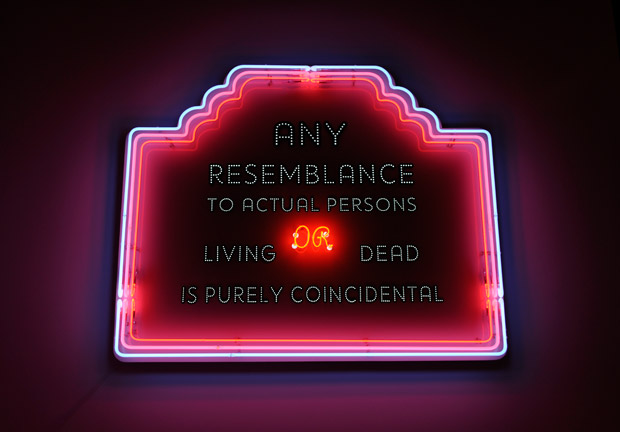 Any Resemblance to Actual Persons, Living or Dead, Is Purely Coincidental / Powder coating paint on aluminum light box, 11 multi color neon sections, 148x120x14 cm, ed. of 2 + 1 AP, 2012 / Photo by Islamic Arts Magazine
Any Resemblance to Actual Persons, Living or Dead, Is Purely Coincidental / Powder coating paint on aluminum light box, 11 multi color neon sections, 148x120x14 cm, ed. of 2 + 1 AP, 2012 / Photo by Islamic Arts Magazine
The familiar disclaimer is the result of a lawsuit filed by Russian princess Irina Yusupov against the film producers of the 1932 film 'Rasputin and the Empress'. The film was modeled on her life, so she sued for invasion of privacy, yet parts were entirely inaccurate, so she sued for defamation too. Bouabdellah's works, in line with this, combine reality and illusion, continually provoking us to question which aspects of her profoundly feminist explorations are depicting truth or adversely falsity.
We are subsequently led through a series of self-portraits that express suppressed facets of womankind's feelings towards the inevitable, the actual, and the expected. We confront grimacing faces that reveal the reality behind perpetually upheld masks. Cut black paper is brought vividly to life by the red sequins spewing out of its slits and voids. These works build up to the ultimate form of expression: the scream. Bouabdellah reclaims Munch's Scream (all four completed by 1910) which manifested his violent fear of his surroundings, to depict her absolute distress. This giant fractured portrait, reaching four meters, shows snippets of the screaming face's contour painted in red lacquer that bleeds down the sheets of paper, down the unpainted face.
We move from these overt expressions to two rose windows wryly entitled 'The Wheel of Fortune'. The rose window is symmetrical, made up of curves, and contained within a circle. It is the glorification of ornamental patterning, and its description could be read as that of a woman's appearance. The work must be read from a distance at first, as purely ornamental, but to be understood must be studied in great detail, for the realm on the other side of the rose window to emerge.
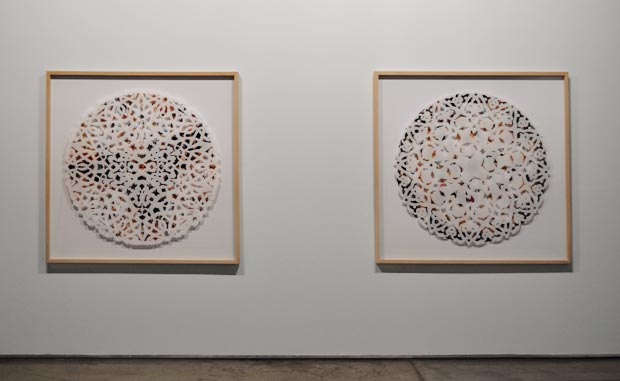 'The Wheel of Fortune I, II' / C print mounted on Alucobound and Plexiglas, diam. 120 cm each, dimensions with frame 145x145 cm, ed. of 3 +1AP, 2012 / Photo by Islamic Arts Magazine
'The Wheel of Fortune I, II' / C print mounted on Alucobound and Plexiglas, diam. 120 cm each, dimensions with frame 145x145 cm, ed. of 3 +1AP, 2012 / Photo by Islamic Arts Magazine
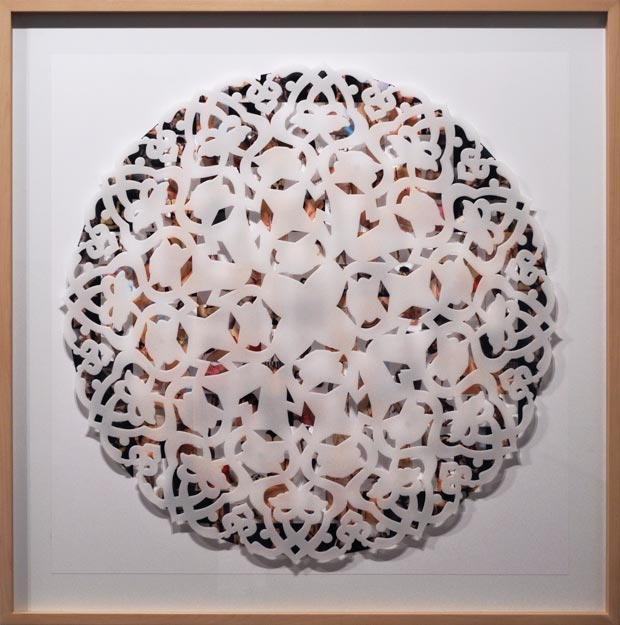 'The Wheel of Fortune I / C print mounted on Alucobound and Plexiglas, diam. 120 cm, dimensions with frame 145x145 cm, ed. of 3 +1AP, 2012 / Photo by Islamic Arts Magazine
'The Wheel of Fortune I / C print mounted on Alucobound and Plexiglas, diam. 120 cm, dimensions with frame 145x145 cm, ed. of 3 +1AP, 2012 / Photo by Islamic Arts Magazine
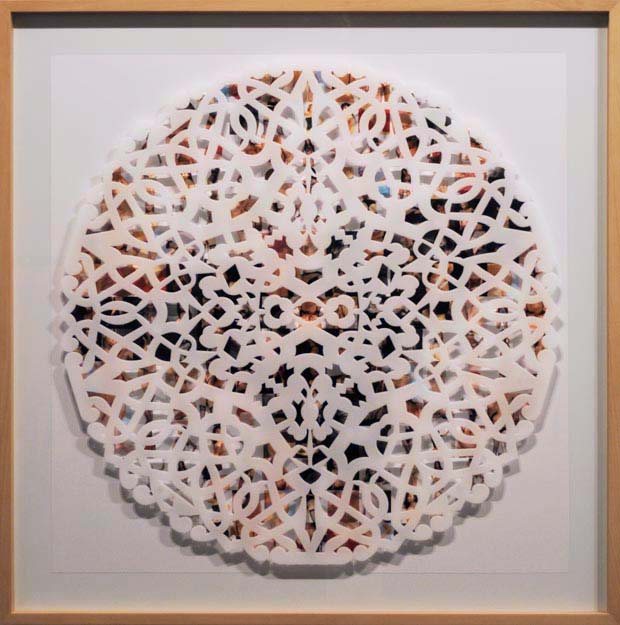 'The Wheel of Fortune II / C print mounted on Alucobound and Plexiglas, diam. 120 cm, dimensions with frame 145x145 cm, ed. of 3 +1AP, 2012 / Photo by Islamic Arts Magazine
'The Wheel of Fortune II / C print mounted on Alucobound and Plexiglas, diam. 120 cm, dimensions with frame 145x145 cm, ed. of 3 +1AP, 2012 / Photo by Islamic Arts Magazine
An installation piece of the eight gates of paradise, three of which are on show, entice us to cross the thresholds between reality and fantasy, woman and man, concealment and acknowledgement. An engraved plaque, a pair of red high heels, glistening beads and vividly coloured walls, all beckon us to venture into a fantastical paradise, a sacred realm of perfection, echoing the realm depicted behind the rose windows.
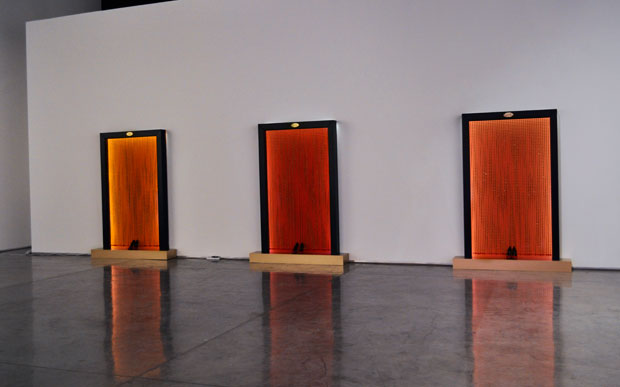 Installation view, An installation piece of the eight gates of paradise / Photo by Islamic Arts Magazine
Installation view, An installation piece of the eight gates of paradise / Photo by Islamic Arts Magazine
 One gate from an installation piece of the eight gates of paradise / Photo by Islamic Arts Magazine
One gate from an installation piece of the eight gates of paradise / Photo by Islamic Arts Magazine
The sacred is then sidelined by fifteen pop mosques that dismiss ideology and restrictive preconceptions to focus on reality. Only the contours of the mosques are depicted, celebrating each one's architectural individuality and highlighting the expansive diversity that exists in architecture across the globe, from Burkina-Faso to Lebanon and Germany.
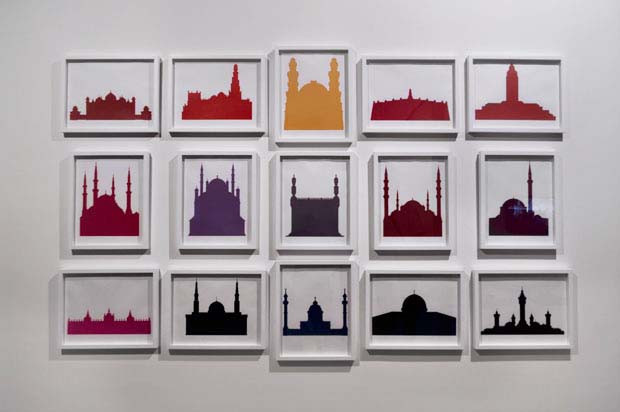 'Pop Mosques' / Overall installation approx. 255 x 156 cm, 15 panels 47 x 37 cm each, Ink on paper and varnish with micro glitter. Edition of 2, 2012 / Photo by Islamic Arts Magazine
'Pop Mosques' / Overall installation approx. 255 x 156 cm, 15 panels 47 x 37 cm each, Ink on paper and varnish with micro glitter. Edition of 2, 2012 / Photo by Islamic Arts Magazine
The lustrous sparkling of the glittered serigraphy prints is picked up by the glistening of a Yemeni woman's sequin-encrusted veil as she dances in a video where music is replaced by criticisms of behaviour and public appearance. She appears as perfection from the outside, but the voice that follows her graceful movements narrates a different idea.
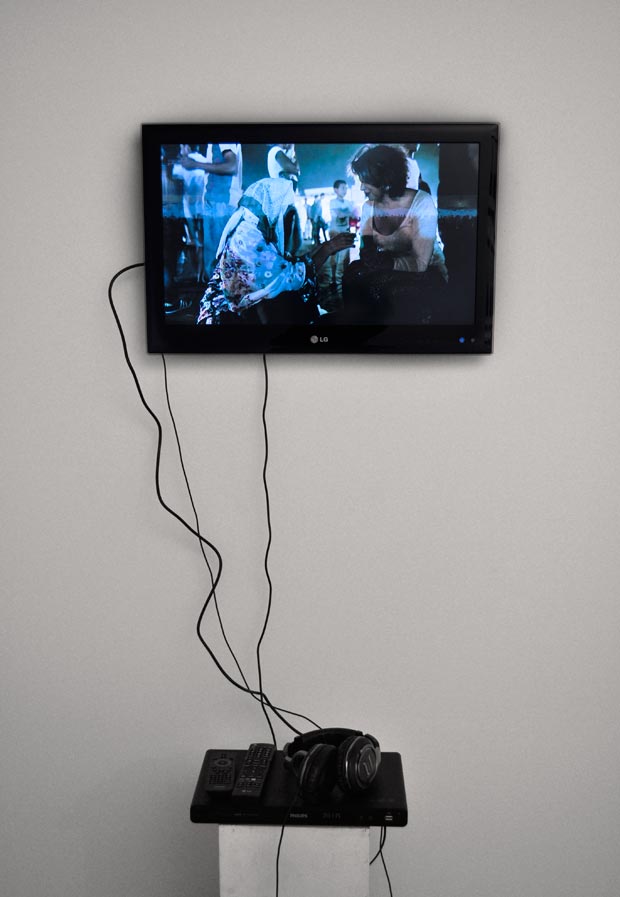 Dis-Lui / Video, 6 minutes and 23 seconds. Edition of 3 + 2 AP, 2012 / Photo by Islamic Arts Magazine
Dis-Lui / Video, 6 minutes and 23 seconds. Edition of 3 + 2 AP, 2012 / Photo by Islamic Arts Magazine
The exhibition declares from the outset that things are not what they appear to be. By constructing a form of theatre, Bouabdellah shows us that not only is reality not what it first seems, but also that it is constructed, and as such, changeable.
The exhibition will run until December 6, 2012 at Gallery Isabelle Van Den Eynde in Dubai.
Comments
Add a comment